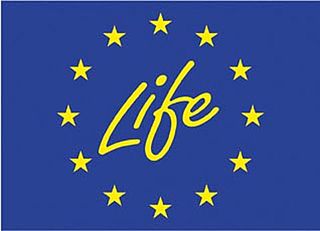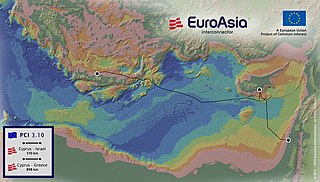Related Research Articles

The European emission standards are vehicle emission standards for pollution from the use of new land surface vehicles sold in the European Union and European Economic Area member states and the United Kingdom, and ships in EU waters. The standards are defined in a series of European Union directives staging the progressive introduction of increasingly stringent standards.
The European Union Agency for Cybersecurity – self-designation ENISA from the abbreviation of its original name – is an agency of the European Union. It is fully operational since September 1, 2005. The Agency is located in Athens, Greece and has offices in Brussels, Belgium and Heraklion, Greece.
The European Institute of Innovation and Technology (EIT) is an independent body of the European Union with juridical personality, established in 2008 intended to strengthen Europe's ability to innovate. The EIT’s three “core pillars” of activities are: entrepreneurial education programmes and courses across Europe that transform students into entrepreneurs; business creation and acceleration services that scale ideas and budding businesses; and innovation-driven research projects that turn ideas into products by connecting partners, investors, and expertise.
ENTSO-E, the European Network of Transmission System Operators, represents 39 electricity transmission system operators (TSOs) from 35 countries across Europe, thus extending beyond EU borders. ENTSO-E was established and given legal mandates by the EU's Third Package for the Internal energy market in 2009, which aims at further liberalising the gas and electricity markets in the EU.

Directive 2003/30/EC was a European Union directive for promoting the use of biofuels for EU transport. The directive entered into force in May 2003, and stipulated that national measures must be taken by countries across the EU aiming at replacing 5.75% of all transport fossil fuels with biofuels by 2010. The directive also called for an intermediate target of 2% by 31 December 2005. The target of 5.75% was to be met by 31 December 2010. These percentages were to be calculated on the basis of energy content of the fuel and were to apply to petrol and diesel fuel for transport purposes placed on the markets of member states. Member states were encouraged to take on national "indicative" targets in conformity with the overall target.

The energy policy of the European Union focuses on energy security, sustainability, and integrating the energy markets of member states. An increasingly important part of it is climate policy. A key energy policy adopted in 2009 is the 20/20/20 objectives, binding for all EU Member States. The target involved increasing the share of renewable energy in its final energy use to 20%, reduce greenhouse gases by 20% and increase energy efficiency by 20%. After this target was met, new targets for 2030 were set at a 55% reduction of greenhouse gas emissions by 2030 as part of the European Green Deal. After the Russian invasion of Ukraine, the EU's energy policy turned more towards energy security in their REPowerEU policy package, which boosts both renewable deployment and fossil fuel infrastructure for alternative suppliers.
The Commissioner for Industry and Entrepreneurship was a vice-president of the European Commission.
The European Agricultural Fund for Rural Development (EAFRD) is one of the European Structural and Investment Funds which was set up for the financing of Rural Development Programme (RDP) actions by European Union Council Regulation (EC) No 1290/2005 of 21 June 2005 on the financing of the Common Agricultural Policy (CAP).

The LIFE programme is the European Union's funding instrument for the environment and climate action. The general objective of LIFE is to contribute to the implementation, updating and development of EU environmental and climate policy and legislation by co-financing projects with European added value. LIFE began in 1992 and to date there have been five phases of the programme. During this period, LIFE has co-financed some 4600 projects across the EU, with a total contribution of approximately 6.5 billion Euros to the protection of the environment and of climate. For the next phase of the programme (2021–2027) the European Commission proposed to raise the budget to 5.45 billion Euro.

The European Union has concluded free trade agreements (FTAs) and other agreements with a trade component with many countries worldwide and is negotiating with many others. The European Union negotiates free trade deals on behalf of all of its member states, as the member states have granted the EU has an "exclusive competence" to conclude trade agreements. Even so, member states' governments control every step of the process :
Environmental issues in the European Union include the environmental issues identified by the European Union as well as its constituent states. The European Union has several federal bodies which create policy and practice across the constituent states.
The European Union's Third Energy Package is a legislative package for an internal gas and electricity market in the European Union. Its purpose is to further open up the gas and electricity markets in the European Union. The package was proposed by the European Commission in September 2007, and adopted by the European Parliament and the Council of the European Union in July 2009. It entered into force on 3 September 2009.

The EuroAsia Interconnector is a HVDC interconnector between the Greek, Cypriot, and Israeli power grids via the world's longest submarine power cable. Connecting Kofinou, Cyprus to Hadera, Israel and Korakias, Crete, Greece the EuroAsia Interconnector is a major Project of Common Interest of the European Union and a priority Electricity Highway Interconnector Project, as an energy highway bridging Asia and Europe. Regulatory approval of electricity interconnection between Cyprus and Greece was completed on October 10, 2017.

The European Commission's Asylum, Migration and Integration Fund is a funding programme managed by the Directorate-General for Migration and Home Affairs which promotes the efficient management of migration flows and the implementation, strengthening and development of a common approach to asylum and immigration in the European Union. All EU Member States except Denmark participate in the implementation of this Fund. Most of the funds are provided to the EU Member States for activities addressing previously agreed upon themes. A part of the funding is reserved for emergency assistance. A final part is reserved for Union Actions, which are European Commission managed projects that are developed as either calls for proposals, direct awards, procurements, or delegation agreements.
The European Research Executive Agency is a funding body mandated by the European Commission to support the EU Research and Innovation policy. It has been established by the European Commission, based on Council Regulation (EC) No 58/2003.

The Directorate-General for Defence Industry and Space is a department of the European Commission.

The European Green Deal, approved in 2020, is a set of policy initiatives by the European Commission with the overarching aim of making the European Union (EU) climate neutral in 2050. The plan is to review each existing law on its climate merits, and also introduce new legislation on the circular economy, building renovation, biodiversity, farming and innovation.
References
- 1 2 "EUR-Lex - 32013R0347 - EN - EUR-Lex". eur-lex.europa.eu. Retrieved 2023-03-28.
- ↑ "Projects of Common Interest". gastivists.org/. Retrieved 2019-08-21.
- ↑ "What are the Projects of Common Interest? How do they improve and modernise Europe's energy grid?". audiovisual.ec.europa.eu. Retrieved 2019-09-21.
- ↑ "Navigating the roadmap for clean, secure and efficient energy innovation" (PDF). set-nav.eu. Retrieved 2019-09-21.
- ↑ "EU Member States voted to invest almost €800 million in key European energy infrastructure projects with major cross-border benefits". crossbowproject.eu. Retrieved 2019-09-21.
- ↑ "Four priorities for a future-oriented Connecting Europe Facility". euractiv.com. Retrieved 2019-09-21.
- ↑ "€4 billion investment package for infrastructure projects across 10 Member States". ec.europa.eu. Retrieved 2019-09-21.
- ↑ "EUR-Lex - 52014XC0620(01) - EN - EUR-Lex". eur-lex.europa.eu. Retrieved 2023-03-28.
- ↑ EU press corner (2018-12-18). "State aid: Commission approves plan by France, Germany, Italy and the UK to give €1.75 billion public support to joint research and innovation project in microelectronics". European Commission - European Commission. Retrieved 2023-03-28.
- ↑ "EUR-Lex - 52020PC0824 - EN - EUR-Lex". eur-lex.europa.eu. Retrieved 2023-03-28.
- ↑ "Projects of Common Interest". ec.europa.eu. Retrieved 2019-08-20.
- ↑ "Achieving European Global Leadership in Renewable Energy". europeanfiles.eu. Retrieved 2019-08-20.
- ↑ "Call for applications for candidate projects of common interest (PCIs) in electricity". ec.europa.eu. Retrieved 2019-09-20.
- ↑ "A push for Projects of Common Interest". tyndp.entsoe.eu. Retrieved 2019-09-20.
- ↑ "Evaluation of the TEN-E regulation". ec.europa.eu. Retrieved 2019-09-20.
- ↑ "'Projects of Common Interest', or waste of public resources?". euractiv.com. Retrieved 2019-09-20.
- ↑ Eddy, Melissa (2023-03-27). "Germany Wants More Chip Makers, but They Won't Come Cheap". The New York Times. ISSN 0362-4331 . Retrieved 2023-03-28.
- ↑ "Wolfspeed Announces Plan to Construct World's Largest, Most Advanced Silicon Carbide Device Manufacturing Facility in Saarland, Germany". www.wolfspeed.com. 2023-02-01. Retrieved 2023-03-28.